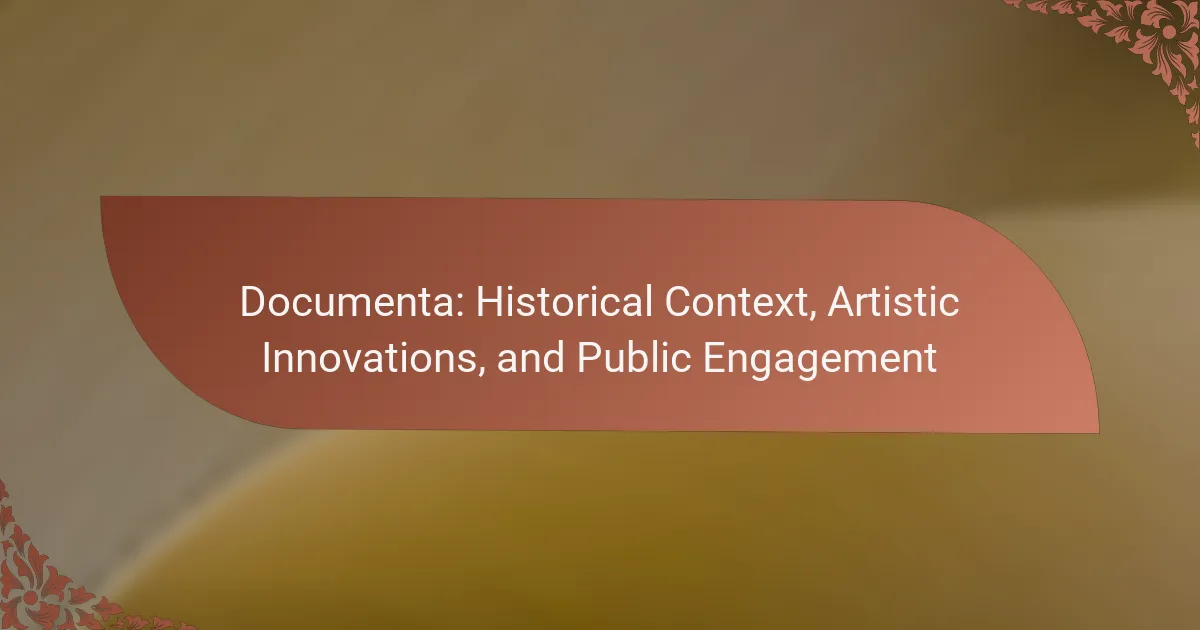Documenta offers a vital exploration of contemporary art and cultural discourse. It originated in post-World War II Germany to promote artistic renewal and public dialogue. The event showcases significant artistic innovations, emphasizing interdisciplinary practices and global perspectives. Documenta also engages local communities through inclusive programming, addressing themes like globalization and identity while navigating the challenges of evolving audience expectations.
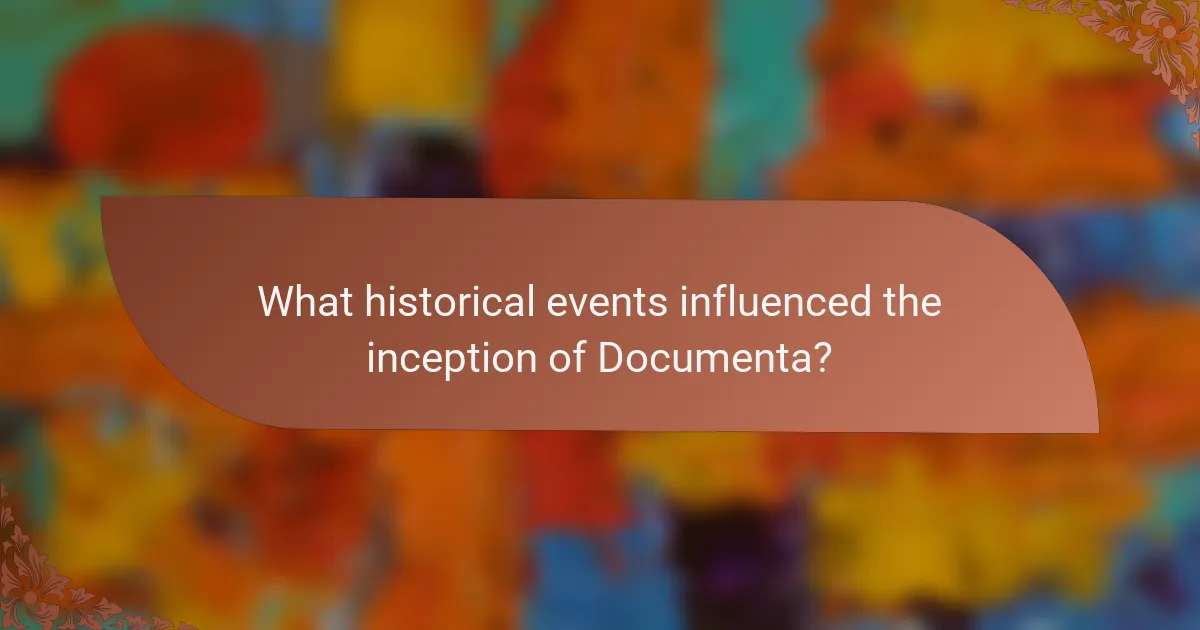
What historical events influenced the inception of Documenta?
The inception of Documenta was influenced by post-World War II cultural recovery and the need for artistic renewal. Established in 1955 by Arnold Bode in Kassel, Germany, Documenta aimed to showcase contemporary art and promote dialogue on modernism. The historical context included the rise of avant-garde movements and a rejection of Nazi-era art censorship. Documenta’s emphasis on public engagement and innovative artistic expressions has evolved through its exhibitions, reflecting societal changes and artistic trends over the decades.
How did post-war Germany shape the first Documenta in 1955?
Post-war Germany significantly influenced the first Documenta in 1955 by fostering a climate of artistic renewal and cultural dialogue. The event aimed to reconnect Germany with contemporary art after the devastation of World War II. Artists sought to address themes of recovery and identity, reflecting the societal need for healing and introspection. Documenta showcased innovative works that challenged traditional boundaries, emphasizing the importance of public engagement in the artistic process. This approach marked a pivotal moment in redefining Germany’s cultural landscape, promoting democracy and freedom of expression through art.
Which cultural movements were showcased in early Documenta exhibitions?
Early Documenta exhibitions showcased various cultural movements, including modernism, postmodernism, and conceptual art. These movements emphasized innovative artistic expressions and critical engagement with contemporary societal issues. Documenta served as a platform for artists to explore and present avant-garde ideas, fostering dialogue around art’s role in culture. The exhibitions highlighted the significance of interdisciplinary approaches, merging visual art with philosophy and social commentary.
How has Documenta evolved through different political climates?
Documenta has evolved significantly through various political climates, reflecting changing societal values and artistic expressions. Initially, it emerged in post-World War II Germany, symbolizing a desire for cultural renewal. As political tensions fluctuated, Documenta adapted by showcasing diverse international artists and addressing contemporary issues.
During the Cold War, it became a platform for dialogue between East and West, emphasizing the role of art in political discourse. In recent years, Documenta has increasingly focused on themes of globalization and social justice, responding to contemporary political challenges. Each iteration has not only showcased artistic innovation but also engaged the public in critical conversations about the world.
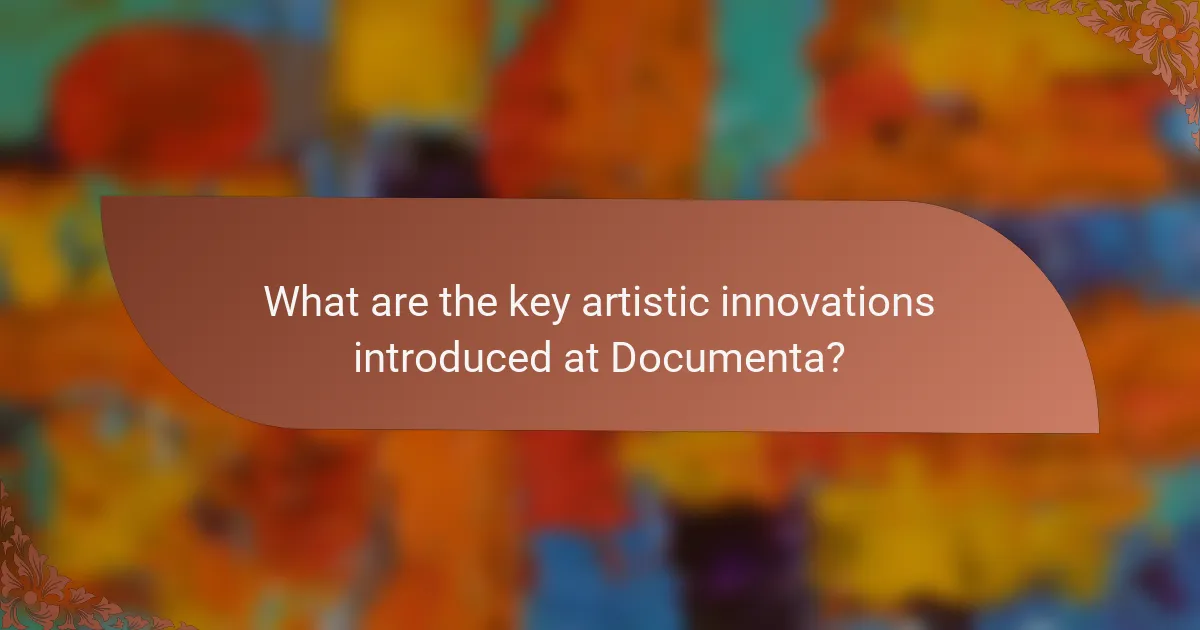
What are the key artistic innovations introduced at Documenta?
Documenta has introduced significant artistic innovations that emphasize interdisciplinary practices and social engagement. Key innovations include the integration of diverse media, participatory art forms, and a focus on global perspectives. These elements reflect Documenta’s commitment to challenging traditional art narratives and fostering dialogue among communities. The event has also embraced digital platforms, enhancing accessibility and interaction with a broader audience.
How have installation art and performance art been integrated into Documenta?
Installation art and performance art have been integral to Documenta, enhancing its engagement with contemporary issues. Documenta incorporates these forms to challenge traditional art boundaries and foster public interaction. For instance, artists like Marina Abramović have used performance to create immersive experiences that provoke dialogue around social themes. Installation art, such as Olafur Eliasson’s works, often transforms spaces, inviting viewers to reflect on their surroundings and the broader environment. This integration reflects Documenta’s commitment to innovation and critical discourse in the art world.
Which groundbreaking artists have defined Documenta’s reputation?
Artists such as Joseph Beuys, Marina Abramović, and Ai Weiwei have significantly shaped Documenta’s reputation. Their innovative approaches have pushed boundaries in contemporary art. Joseph Beuys introduced social sculpture, emphasizing the role of art in societal transformation. Marina Abramović’s performance art challenged audience engagement and physical limits. Ai Weiwei’s activism through art addressed political issues and human rights. Each artist’s unique contributions reflect Documenta’s commitment to artistic innovation and public engagement.
What role does multimedia play in contemporary Documenta exhibitions?
Multimedia plays a crucial role in contemporary Documenta exhibitions by enhancing visitor engagement and broadening artistic expression. It integrates various formats, such as video, sound, and interactive installations, to create immersive experiences. This approach allows artists to communicate complex themes effectively and fosters dialogue among diverse audiences. As a result, multimedia enriches the narrative and emotional depth of the exhibitions, making contemporary art more accessible and relatable.
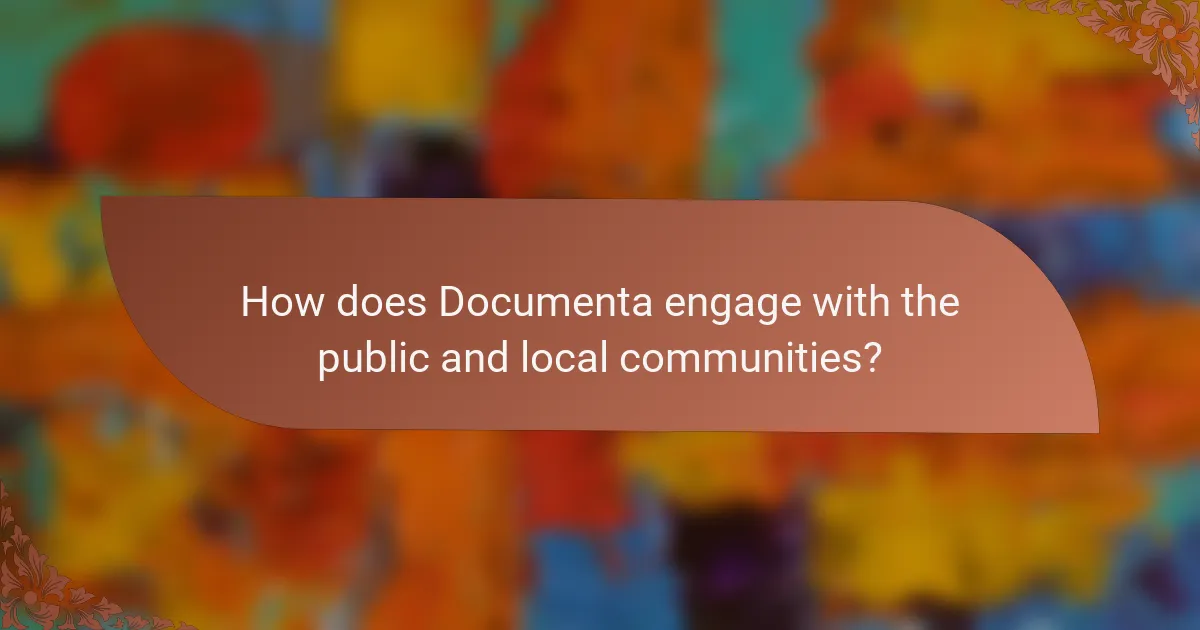
How does Documenta engage with the public and local communities?
Documenta engages with the public and local communities through inclusive programming and collaborative projects. It fosters dialogue by hosting workshops, discussions, and community events that invite participation. This approach enhances local cultural dynamics and promotes accessibility to contemporary art. Documenta’s unique attribute is its commitment to integrating local voices into its exhibitions, ensuring diverse perspectives are represented. This engagement not only enriches the artistic experience but also strengthens community bonds.
What outreach programs has Documenta implemented to enhance public participation?
Documenta has implemented various outreach programs to enhance public participation. These initiatives include community workshops, educational seminars, and collaborative art projects. They aim to engage diverse audiences and foster dialogue about contemporary art. Documenta’s unique approach involves integrating local cultural contexts, ensuring relevance and accessibility. Additionally, partnerships with local organizations amplify outreach efforts, creating a more inclusive environment for public engagement.
How does Documenta adapt its programming for diverse audiences across different regions?
Documenta adapts its programming by incorporating local cultural elements and engaging with regional artists. This approach ensures that exhibitions resonate with diverse audiences. For instance, Documenta often collaborates with local communities to reflect their histories and challenges. This unique attribute enhances public engagement and fosters inclusivity across different regions. Additionally, the programming varies in format, including workshops and discussions, which cater to local interests and needs.
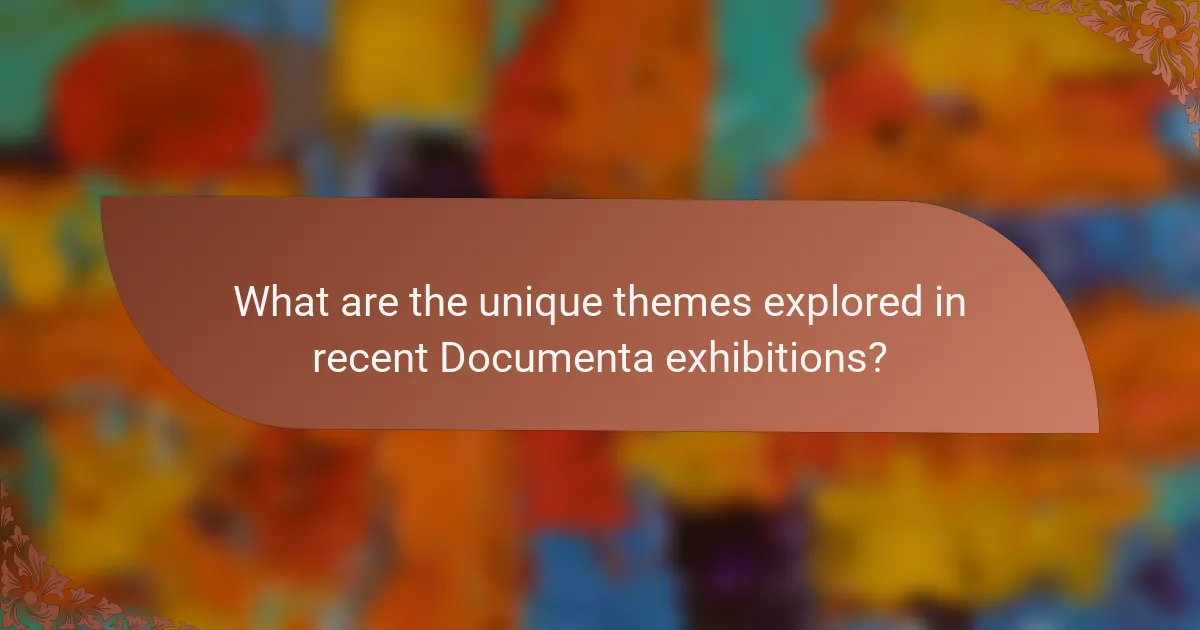
What are the unique themes explored in recent Documenta exhibitions?
Recent Documenta exhibitions explore themes of globalization, identity, and environmental crisis. These themes reflect contemporary societal challenges and artistic innovations. Each exhibition uniquely engages the public through interactive installations and diverse media. The focus on inclusivity and collaboration fosters dialogue on pressing issues.
Which social issues have been highlighted in the latest Documenta events?
The latest Documenta events have highlighted social issues such as migration, climate change, and systemic racism. Artists and curators used their platforms to provoke dialogue and raise awareness about these urgent topics. Documenta’s focus on inclusivity and diverse perspectives has emphasized the importance of addressing these challenges in contemporary society. Notable installations and performances served as powerful commentaries on the intersection of art and activism.
How does Documenta reflect global artistic trends and local narratives?
Documenta reflects global artistic trends while integrating local narratives through diverse exhibitions and participatory projects. This biennial event showcases innovative art from various cultures, encouraging dialogue about contemporary issues. By featuring artists from different backgrounds, Documenta highlights the intersection of global perspectives and local histories, fostering a dynamic space for cultural exchange. The inclusion of community engagement initiatives further emphasizes its commitment to local narratives, making art accessible and relevant to diverse audiences.
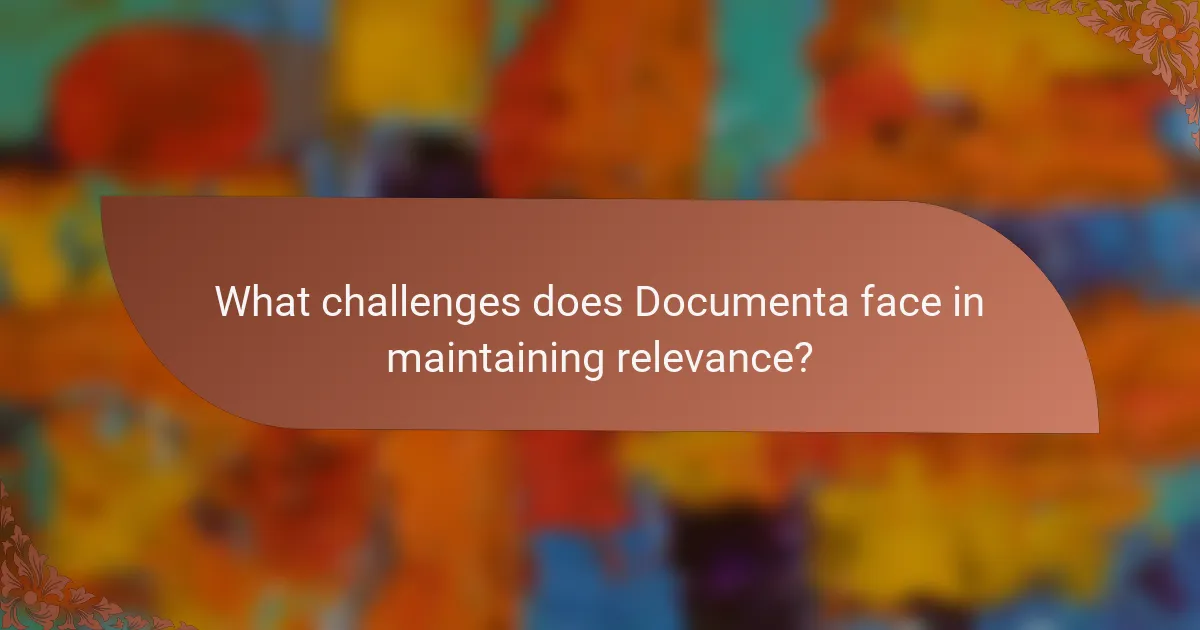
What challenges does Documenta face in maintaining relevance?
Documenta faces challenges in maintaining relevance due to evolving artistic trends and changing audience expectations. The event must balance contemporary innovation with its historical significance. Additionally, competition from global art fairs and digital platforms intensifies the struggle for attention. Engaging diverse demographics while preserving its identity remains a critical hurdle.
How does Documenta address criticism of elitism in the art world?
Documenta addresses criticism of elitism in the art world by prioritizing inclusivity and community engagement. The event features diverse artists and encourages public participation through accessible programming. This approach aims to dismantle traditional barriers in the art scene. Documenta’s focus on global perspectives fosters dialogue and challenges the notion of exclusivity in contemporary art.
What strategies are in place to ensure sustainability in future exhibitions?
Documenta employs various strategies to ensure sustainability in future exhibitions. These include using eco-friendly materials, promoting local artists, and implementing energy-efficient practices. Collaboration with environmental organizations enhances the exhibition’s ecological impact. Regular assessments help improve sustainability measures over time.
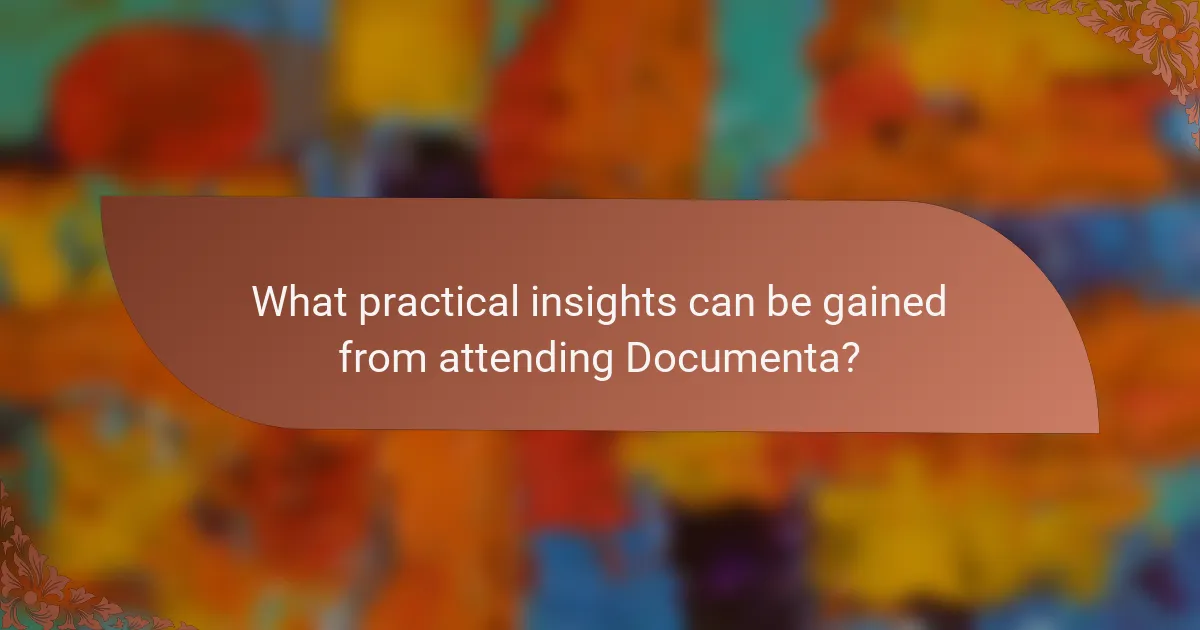
What practical insights can be gained from attending Documenta?
Attending Documenta provides insights into contemporary art, cultural discourse, and community engagement. Participants gain exposure to innovative artistic expressions and can engage in critical discussions on social issues. Documenta serves as a platform for artists to challenge conventions and provoke thought, fostering a deeper understanding of global artistic trends. The collaborative nature of the event encourages networking among artists, curators, and audiences, enhancing the overall cultural dialogue.
How can visitors maximize their experience at Documenta exhibitions?
Visitors can maximize their experience at Documenta exhibitions by engaging actively with the art and participating in discussions. Understanding the historical context enhances appreciation of the artistic innovations presented. Attending guided tours provides deeper insights into the works and their significance. Engaging with interactive installations fosters a personal connection to the art. Lastly, utilizing digital resources offered by Documenta can provide additional layers of understanding and context.
What common mistakes should attendees avoid when exploring Documenta?
Attendees should avoid distractions and plan their visits strategically. Common mistakes include neglecting to research the artists and themes, underestimating the time needed to explore, and overlooking guided tours. Many miss out on important installations due to lack of preparation. Engaging with the local community and attending discussions can enhance the experience significantly.
